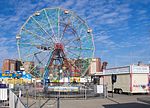Luna Park (Coney Island, 2010)
Luna Park is an amusement park in Coney Island, Brooklyn, New York City. It opened on May 29, 2010, at the site of Astroland, an amusement park that had been in operation from 1962 to 2008, and Dreamland, which operated at the same site for the 2009 season. It was named after the original 1903 Luna Park which operated until 1944 on a site just north of the current park's 1000 Surf Avenue location. The park was designed, developed, and operated by Central Amusement International, LLC (CAI), a subsidiary of the Italian company Zamperla which built 19 new mechanical rides for the park. There are also interactive games, food and beverage concessions, and live entertainment. As of 2017, the park's general manager was Fernando Velasquez.
Excerpt from the Wikipedia article Luna Park (Coney Island, 2010) (License: CC BY-SA 3.0, Authors).Luna Park (Coney Island, 2010)
Surf Avenue, New York Brooklyn
Geographical coordinates (GPS) Address Phone number Website External links Nearby Places Show on map
Geographical coordinates (GPS)
| Latitude | Longitude |
|---|---|
| N 40.573972 ° | E -73.978479 ° |
Address
Luna Park
Surf Avenue 1000
11224 New York, Brooklyn
New York, United States
Open on Google Maps










